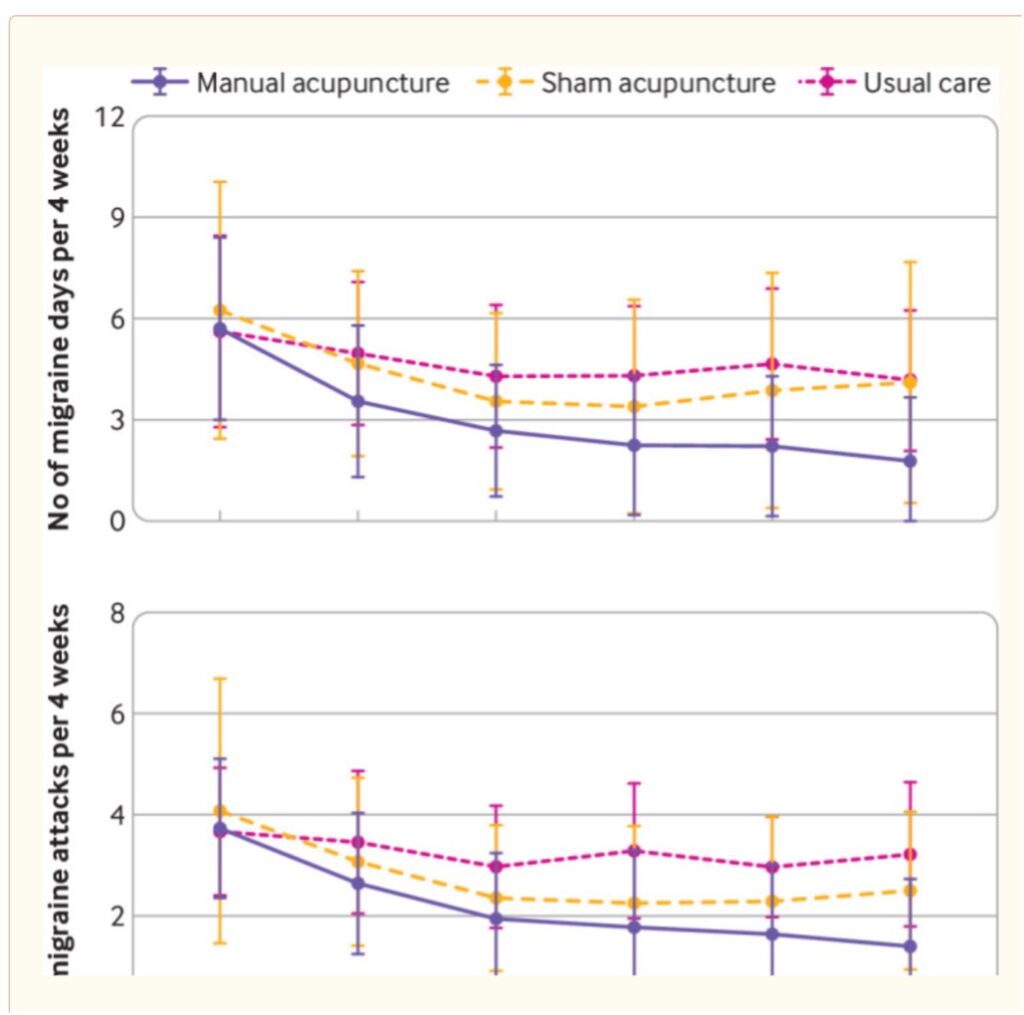https://www.ncbi.nlm.nih.gov/pmc/articles/PMC7249245/
Manual acupuncture versus sham acupuncture and usual care for prophylaxis of episodic migraine without aura: multicentre, randomised clinical trial
- The latest Global Burden of Disease Study showed that 1.25 billion people had migraine in 2017. In the 15-49 year age group, migraine was the top cause of life lived with disability.
- Although according to current guidelines Sumatriptan is considered an extremely effective migraine-abortive medication with minimal side effects. It is effective for approximately 70% of patients and since many patients refuse to take any medication, studies show that only 13% of patients reported current use of preventive drugs.
- From my interaction with patients, many are more open to non-drug interventions as not a lot of people want to “go on a pill”, not to mention adherence issues once they do get a prescription.
- This paper posted in 2020 discusses a randomized, single blind, three arm clinical trial that was conducted in seven centers in China between 2016 and 2018.
- Participants were randomly selected from patients diagnosed with episodic migraine without aura on the basis of the International Classification of Headache Disorders.
- Among others, inclusion criteria were: adult patients ages 15-65, naivety to acupuncture, and history of migraine without aura for over 12 months
- Exclusion criteria were basically a history of any other neurological disorders, pregnancy and breastfeeding.
- All patients received 20 sessions of 30 minute acupuncture treatments or usual care over eight weeks
- In a ratio of 2:2:1, patients received an actual acupuncture, a sham acupuncture (needles placed not in the acupuncture points) and a placebo (patients felt the prick bun to acupuncture was performed)
- Other than that, all patients received the same care.
- The primary outcomes were change in the mean number of migraine days and migraine attacks per four week cycle during weeks one to 20 after randomization compared with baseline
- The reduction of migraine days and migraine attacks per four weeks from baseline was significantly greater in the manual acupuncture group than in the usual care group during weeks 1 to 20. Compared with sham acupuncture, manual acupuncture resulted in a significantly greater reduction in migraine days during weeks 13 to 20


Comparison with other studies:
Another RCT showed that electrical acupuncture resulted in a long term reduction in migraine attacks. At week 16 after randomization, a greater reduction was observed in the true electrical acupuncture group than in the sham acupuncture group (difference of 1.1 (0.4 to 1.9) attacks) and in the true electrical acupuncture group than the no acupuncture group (difference of 1.8 (1.1 to 2.5) ).
Clinical Relevance:
A considerable number of patients do not respond well to drug treatment, cannot tolerate the adverse effects of drugs, or have contraindications, which can lead to low adherence, chronification of headache, and acute drug overuse
Conclusion:
Among acupuncture naive patients with episodic migraine without aura, treatment with manual acupuncture, compared with sham acupuncture or usual care, resulted in a significantly greater reduction in the frequency of migraine days and migraine attacks. Acupuncture can be recommended as a prophylactic treatment when updating the guidelines and insurance coverage for migraine and its related substance misuse. When discussing prophylactic treatment strategies with patients, clinicians should provide them with information about acupuncture as an option.


